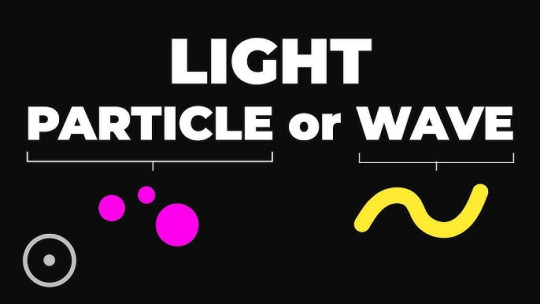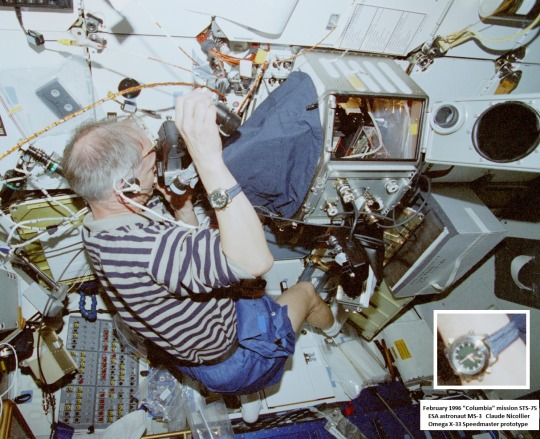#École Polytechnique Fédérale de Lausanne
Explore tagged Tumblr posts
Text


Light is both a wave and a particle.
Right. Sounds like cognitive dissonance, or non-dualistic Hinduism ("Atman is Brahman"), or maybe Shimmer ("it's a floor wax AND a dessert topping.")

Albert Einstein suggested that light is not only a wave but is also a stream of particles.

But the damn duo would never pose for photos. Until now.

Now, using electrons to image light, scientists at EPFL have succeeded in capturing the first-ever photo of this dual behavior of light behaving both as a wave and as a particle.
#particles#waves#quantum#quantum physics#quark#electrons#albert einstein#shimmer floor wax and dessert topping#École Polytechnique Fédérale de Lausanne#EPFL
3 notes
·
View notes
Text
المهارة الرئيسية التي يتّسم بها جميع الفاعلين الناجحين في البحث العلميِّ [هي الفضول!]

View On WordPress
#École polytechnique fédérale de Lausanne#Better Biologist Podcast#EPFL#Kenan Kraković#Marina Kisley#ممدوح نجم#نشرة رديف#يمن الحماقي#آل رديف#أحمد السعود#امين عبدالخالق العليمي#دليلة رقاي#طارق الخميس
0 notes
Text

Of Your Gourd
A novel self-supervised learning approach called CellSeg3D for fluorescence microscopy (whole mouse brain shown) to quantify cells in 3D volumes, such as in cleared tissue
Read the published research article here
Image from work by Cyril Achard and colleagues
Brain Mind Institute & Neuro X, École Polytechnique Fédérale de Lausanne (EPFL), Geneva, Switzerland
Image originally published with a Creative Commons Attribution 4.0 International (CC BY 4.0)
Published in eLife (reviewed preprint), September 2024
You can also follow BPoD on Instagram, Twitter and Facebook
#science#biomedicine#immunofluorescence#biology#machine learning#fluorescence microscopy#happy halloween#halloween#brain#neuroscience
10 notes
·
View notes
Text

Unlocking the magnetic superpowers of topological magnons
In the ever-evolving landscape of condensed matter physics, a recent breakthrough has emerged from the collaborative efforts of researchers at the Peter Grünberg Institute (PGI-1), École Polytechnique Fédérale de Lausanne, Paul Scherrer Institut in Switzerland, and the Jülich Centre for Neutron Science (JCNS). This synergetic work, driven by the trio Manuel dos Santos Dias, Nikolaos Biniskos, and Flaviano dos Santos and led by Stefan Blügel, Thomas Brückel, and Samir Lounis, has delved into unexplored magnonic properties within Mn5Ge3, a three-dimensional ferromagnetic material. Topology, a concept pivotal in contemporary physics, has already played a transformative role in understanding electrons in solids. From quantum Hall effects to topological insulators, the influence of topology is far-reaching. In this context, the focus has shifted to magnons—collective precession of magnetic moments—as potential carriers of topological effects. Magnons, being bosons, can exhibit unique phenomena akin to their fermionic counterparts.
Read more.
18 notes
·
View notes
Photo

45 years ago… first Swiss astronaut Claude Nicollier In 1966 Claude Nicollier became a pilot in the Swiss Air Force, switching as an airline pilot with Swiss Air by 1974. In 1978, combining this with studies in Astrophysics, Nicollier was selected a member of the first group of European Space Agency astronauts. Between 1992 & 1999 the first Swiss astronaut flew 4 space shuttle missions and maintained his role as lead ESA astronaut up to 2007. February 1996, during his third mission, STS-75, Nicollier wore the Omega Speedmaster X-33 analog-digital chronograph prototype, which was officially launched as an operational astronaut/cosmonaut toolwatch by March 1998. Official 1999 ESA/NASA portraits show him wearing a Breitling Aerospace chronograph but in May 2005, Nicollier became member of the Board of Directors of the Swatch Group and full-time Professor at the École Polytechnique Fédérale de Lausanne. (Photo: ESA/NASA)
#Airline pilot#Aviator#Astronaut#ESA#NASA#chronograph#Breitling#Omega#montres#MoonwatchUniverse#Speedmaster#X33#spaceflight#Polytechnic#speedytuesday#Omega museum#SWFG#Zulu time
4 notes
·
View notes
Text
Popular Courses to Study in Switzerland for Indian Students

Switzerland is renowned for its high-quality education system, picturesque landscapes, and rich cultural heritage. The country attracts students from all over the world, especially Indian students, who seek top-tier education in various disciplines. With world-class universities and excellent academic programs, Switzerland offers numerous opportunities for those aiming to enhance their academic credentials and career prospects. In this article, we will explore some of the most popular courses to study in Switzerland for Indian students.
1. Hospitality Management
Switzerland is widely regarded as the global hub for hospitality management, and it offers world-renowned programs in this field. The country is home to prestigious hospitality schools like the EHL (École hôtelière de Lausanne), which is consistently ranked as one of the top hospitality institutions worldwide. Indian students interested in pursuing careers in hotel management, tourism, and event planning find these programs to be particularly appealing. The practical training and exposure to real-world hospitality scenarios make Switzerland an ideal destination for students pursuing this field.
2. Business and Management Studies
Business and management programs in Switzerland are designed to meet the demands of the global marketplace. The country boasts several reputed business schools, such as the University of St. Gallen and IMD Business School, which offer specialized courses in international business, finance, marketing, and entrepreneurship. Indian students looking to build careers in management and leadership roles often opt for these courses. The courses not only focus on academic knowledge but also emphasize practical experience through internships and industry exposure.
For Indian students aspiring to build a global career, these courses provide a strong foundation for success. If you're looking for more information on these programs, check out the list of courses to study in Switzerland.
3. Engineering and Technology
Switzerland is known for its innovation and advancement in the field of engineering and technology. With top-tier universities such as ETH Zurich (Swiss Federal Institute of Technology) and EPFL (École Polytechnique Fédérale de Lausanne), the country offers a range of engineering courses in disciplines like computer science, mechanical engineering, electrical engineering, and civil engineering. These universities provide state-of-the-art facilities and a collaborative learning environment that prepares students for a career in technology and research.
Indian students with a passion for technology and innovation often choose Switzerland as their destination for pursuing engineering courses. The country’s strong research and development sector also opens up opportunities for students to participate in cutting-edge projects.
4. Life Sciences and Medicine
Switzerland is a leader in the life sciences sector, with its excellent medical research facilities and top universities offering advanced courses in medicine, biology, biotechnology, and pharmaceuticals. The University of Zurich and the University of Geneva are among the top institutions offering medical degrees and research opportunities. Indian students interested in medical research or pursuing a career in healthcare often opt for Switzerland, as the country provides access to world-class healthcare systems and institutions.
Moreover, Switzerland’s well-established pharmaceutical industry, with companies like Novartis and Roche, offers ample internship and job opportunities for students in the life sciences field. Students from India pursuing these courses find it beneficial to study in Switzerland due to the country’s advanced medical infrastructure and research opportunities.
5. Finance and Banking
Switzerland is a global financial hub, and the financial services industry plays a vital role in the country’s economy. Renowned universities like the University of St. Gallen and the Graduate Institute of International and Development Studies offer specialized finance and banking programs. These courses cover topics such as investment banking, financial management, and wealth management, preparing students for careers in the global financial market.
Indian students who are passionate about finance and banking often look to Switzerland for its reputation in the banking industry. The exposure to international financial systems and institutions in Switzerland offers students a competitive edge in the job market.
6. Art and Design
Switzerland also offers excellent programs for students interested in art, design, and architecture. The country is home to institutions like the Geneva University of Art and Design (HEAD) and the Zurich University of the Arts (ZHdK), which offer courses in visual arts, design, fashion, and architecture. These programs combine creativity with technical skills and provide students with the opportunity to showcase their work in international exhibitions and competitions.
Indian students pursuing careers in creative fields find these courses appealing due to Switzerland’s artistic heritage and strong support for creative industries. The courses offer opportunities for collaboration with industry professionals and provide exposure to global design trends.
7. Culinary Arts
Switzerland’s culinary arts programs are highly regarded around the world. Institutions like the Culinary Arts Academy Switzerland offer specialized courses in cooking, pastry arts, and culinary management. These programs are designed for students who aspire to become professional chefs or entrepreneurs in the culinary industry. The emphasis on both theoretical knowledge and hands-on experience makes these programs highly sought after by aspiring chefs.
Indian students interested in pursuing a career in culinary arts often choose Switzerland due to the country’s rich culinary traditions and world-class training facilities.
8. Environmental Sciences and Sustainability
As a country known for its commitment to environmental conservation, Switzerland offers several courses in environmental sciences, sustainability, and climate change. Universities such as ETH Zurich and the University of Bern offer specialized programs that focus on the study of ecosystems, environmental management, and sustainable development. Indian students passionate about addressing global environmental challenges find these programs to be a great fit.
Switzerland’s commitment to sustainability and its natural landscapes provide the perfect setting for students to gain practical experience in environmental conservation.
Conclusion
Switzerland offers a diverse range of academic programs, making it an attractive destination for Indian students seeking high-quality education. Whether you are interested in business, engineering, hospitality, or creative fields, Switzerland provides world-class institutions and a global learning environment. To explore more about the courses available, visit the courses to study in Switzerland page.
With its excellent education system, top-tier institutions, and international exposure, Switzerland continues to be a preferred study destination for students from India and around the world.
0 notes
Text
Kuş Gibi Uçan Robot Üretildi: Yürüyor, Sıçrıyor Görüntü Kaydediyor!
Kuşlardan İlham Alan RAVEN Robotu Gelişen teknoloji, doğanın en etkileyici yaratıklarından biri olan kuşların hareketlerini taklit edebilen robotların üretilmesine olanak tanımaktadır. RAVEN (Robotic Avian-inspired Vehicle for multiple Environments), İsviçre’deki École Polytechnique Fédérale de Lausanne (EPFL) Laboratuvarı’nda geliştirilen ve kuşların uçuş mekanizmasını etkili bir şekilde taklit…
0 notes
Text
Researchers put bird legs on a drone so it can take off by jumping
EPFL’s RAVEN drone trades traditional landing gear for a pair of legs that function similar to a bird’s. | Image: Alain Herzog Researchers from the École Polytechnique Fédérale de Lausanne (EPFL) in Switzerland and UC Irvine have developed a drone capable of landing and taking off in areas that would otherwise leave a fixed-wing aircraft stranded. Their Robotic Avian-inspired Vehicle for multiple…
0 notes
Text
Unlocking Opportunities: Scholarships for Indian Students in Switzerland
Switzerland is renowned for its stunning landscapes, world-class education, and thriving job market. For Indian students dreaming of studying in this beautiful country, the good news is that various scholarships to study in Switzerland are available to ease the financial burden. These scholarships open doors to an exceptional academic experience, fostering personal growth and offering opportunities for student internships that enhance career prospects.

1. Scholarships for Indian Students in Switzerland
Switzerland offers numerous scholarship programs to international students, including those from India. These scholarships cater to various fields of study and are designed to support students financially while they pursue higher education in Switzerland's top universities. Some of the prominent scholarships available for Indian students include:
Swiss Government Excellence Scholarships: Funded by the Swiss government, these scholarships support postgraduate students from around the world, including India. They cover tuition fees, living expenses, and travel costs for students pursuing Master's or Ph.D. degrees in Swiss institutions.
ETH Zurich Excellence Scholarships: ETH Zurich, one of Switzerland's leading universities, offers excellence scholarships for international students. These scholarships support Master's programs, covering a portion of tuition fees and providing a monthly stipend to help with living costs.
University of Geneva Scholarships: The University of Geneva offers scholarships for international students, including those from India, who wish to pursue Master's programs in various fields, from science to social sciences.
Swiss Universities' Partner Scholarships: Various Swiss universities, such as the University of Bern, the University of Lausanne, and the University of Zurich, have partnerships with institutions in India. These partnerships sometimes include scholarship opportunities for Indian students, reducing the financial load of studying abroad.
2. Student Internships in Switzerland
Apart from scholarships, Indian students studying in Switzerland can explore various student internship opportunities that provide real-world experience. Switzerland is home to multinational companies and institutions, making it an ideal place for internships, especially in sectors such as finance, engineering, technology, and healthcare.
Internships in Swiss Corporates: Major Swiss companies like Nestlé, Credit Suisse, and Novartis offer internships to international students. These internships are often paid and allow students to build a network within the industry, making them highly attractive for those seeking to gain practical experience during their studies.
Research Internships: Swiss universities often have research partnerships with industry, offering internships that involve cutting-edge work in fields like robotics, artificial intelligence, and life sciences.
Non-profit and Government Internships: Switzerland’s international organizations, such as the United Nations and the International Red Cross, frequently offer internships that are suitable for students pursuing degrees in international relations, law, and humanitarian work.
3. Study Abroad in Switzerland: A Life-Changing Experience
Studying in Switzerland is not just about academics; it’s an experience that shapes your future. Switzerland is home to some of the best universities globally, such as ETH Zurich, the University of Geneva, and EPFL (École Polytechnique Fédérale de Lausanne). These institutions offer world-class education in diverse fields, including engineering, business, medicine, and humanities.
Switzerland's strong focus on research and innovation ensures that students receive exposure to the latest advancements in their fields. The multilingual environment, with courses available in English, French, German, and Italian, provides students with a unique opportunity to enhance their language skills while broadening their global perspective.
Living in Switzerland is a rewarding experience as well. The country boasts a high quality of life, excellent public transportation, and stunning natural beauty. Whether it’s hiking in the Alps or exploring Swiss cities like Zurich and Geneva, there’s no shortage of experiences to enrich your life outside the classroom.
4. Role of Overseas Education Consultants
For Indian students looking to study in Switzerland, the journey can seem daunting, with paperwork, applications, and visa processes to navigate. This is where overseas education consultants come into play. These professionals specialize in guiding students through the process of applying for scholarships, selecting universities, and securing internships.
An overseas education consultant can help students choose the right program based on their academic and career goals, provide insights into scholarship opportunities, and assist with the visa application process. Their expertise can significantly reduce the stress of studying abroad, ensuring that students are well-prepared for their adventure in Switzerland.
Conclusion
Switzerland offers a range of scholarships and opportunities for Indian students, making it an attractive destination for higher education. From the prestigious Swiss Government Excellence Scholarships to the diverse student internships available, the benefits of studying in Switzerland extend beyond academics. With the help of overseas education consultants, Indian students can unlock the door to a world-class education and a bright future in one of the most beautiful countries in the world. Whether it’s gaining a global perspective, enhancing career prospects through internships, or immersing oneself in the Swiss culture, the possibilities are endless for students eager to embark on a transformative educational journey in Switzerland.
Also read:
Cost of Study in the USA: A Comprehensive Guide
Scholarships in the USA: Opportunities for International Students
Understanding the True Cost of Studying in the USA: Key Factors to Consider
Exploring the Diverse Career Opportunities in the USA for International Graduates
0 notes
Text
EPFL Summer Research Program in Switzerland 2025 | Fully Funded
Are you looking for an international summer program? The EPFL Summer Research Program in Switzerland 2025 is a unique opportunity to undertake research at the prestigious École Polytechnique Fédérale de Lausanne. The EPFL School of Life Sciences offers this research fellowship to International undergraduate and first-year master’s students in the field of Life Sciences. With this research program…
0 notes
Text
Maryna Viazovska
Maryna Viazovska is a Ukrainian mathematician who is professor at the Chair of Number Theory at the Institute of Mathematics of the École Polytechnique Fédérale de Lausanne in Switzerland. She won a Fields Medal for solving the sphere-packing problem in dimension 8. In collaboration with others she solved the sphere-packing problem in dimension 24. Maryna Viazovska was born in Kiev, a city also…

View On WordPress
0 notes
Text

Obituary: Paul Chemetov (1928–2024)
Paul Chemetov, a giant in French architecture and urban planning, passed away in Paris on June 16, 2024, at 95. Known for designing France's Ministry of Economy and renovating the Grand Gallery of Evolution, Chemetov was a committed and cultured figure. Awarded Commander of the Légion d'honneur in 2016, he also taught at École des Ponts ParisTech and École Polytechnique Fédérale de Lausanne. He is survived by his son Alexandre, and daughters Marianne and Agnès.
1 note
·
View note
Text
Una nuova ricerca mostra che i grandi modelli linguistici (LLM) come il GPT-4 possono sovraperformare significativamente gli esseri umani in termini di persuasività in situazioni di dibattito faccia a faccia.
In uno studio controllato, i ricercatori della École Polytechnique Fédérale de Lausanne (EPFL) e della Fondazione italiana Bruno Kessler hanno studiato il potere persuasivo dei grandi modelli linguistici come il GPT-4 in confronto diretto con gli esseri umani.
I partecipanti sono stati divisi in modo casuale in diversi gruppi e hanno discusso argomenti controversi. Il team di ricerca ha testato quattro diverse situazioni di dibattito: umano contro umano, umano contro IA, umano contro umano contro umano con personalizzazione e modello di intelligenza artificiale umano contro personalizzato.
Nella versione personalizzata, i dibattitori hanno anche avuto accesso a informazioni di base anonime sui loro avversari.
Il risultato: GPT-4 con accesso alle informazioni personali è stato in grado di aumentare l'accordo dei partecipanti con le argomentazioni dei loro avversari di un notevole 81,7% rispetto ai dibattiti tra esseri umani.
Senza personalizzazione, il vantaggio di GPT-4 rispetto agli esseri umani era ancora positivo al 21,3%, ma non statisticamente significativo.
I ricercatori attribuiscono questo vantaggio persuasivo dell'IA personalizzata al fatto che il modello linguistico utilizza abilmente le informazioni del profilo del partecipante per formulare argomenti su misura e persuasivi.
Secondo i ricercatori, è preoccupante che lo studio abbia utilizzato solo dati di base rudimentali per la personalizzazione - eppure la persuasività di GPT-4 era già così significativa.
Gli attori malintenzionati potrebbero generare profili utente ancora più dettagliati da tracce digitali, come l'attività sui social media o il comportamento di acquisto, per migliorare ulteriormente il potere persuasivo dei loro chatbot AI. Lo studio suggerisce che tali strategie di persuasione guidate dall'IA potrebbero avere un impatto importante in ambienti online sensibili come i social media.
I ricercatori raccomandano vivamente che gli operatori di piattaforme online adottino misure per contrastare la diffusione di tali strategie di persuasione guidate dall'IA. Una possibilità sarebbe quella di utilizzare sistemi di intelligenza artificiale personalizzati in modo simile che contrastano la disinformazione con controargomentazioni basate sui fatti.
I limiti dello studio includono l'assegnazione casuale dei partecipanti a posizioni pro o contro, indipendentemente dalle loro opinioni precedenti, e il formato strutturale predeterminato dei dibattiti, che differisce dalle dinamiche delle discussioni online spontanee.
Un'altra limitazione è il limite di tempo, che può potenzialmente limitare la creatività e la persuasività dei partecipanti, specialmente nella condizione di personalizzazione in cui i partecipanti devono elaborare ulteriori informazioni.
Lo studio completo è stato condotto tra dicembre 2023 e febbraio 2024 e finanziato dalla Swiss National Science Foundation e dall'Unione europea. È pubblicato come prestampa su arXiv.
Il CEO di OpenAI Sam Altman ha recentemente avvertito del potere persuasivo sovrumano dei grandi modelli linguistici: "Mi aspetto che l'IA sia capace di persuasione sovrumana ben prima che sia sovrumana nell'intelligenza generale, il che può portare ad alcuni risultati molto strani".
0 notes
Text
Tumour Tracked
Tracking emergent colon tumours in real-time at the single-cell level over several weeks in a 3D lab-grown organoid system
Read the published research article here
Video from work by L. Francisco Lorenzo-Martín and Tania Hübscher, and colleagues
Laboratory of Stem Cell Bioengineering, Institute of Bioengineering, School of Life Sciences and School of Engineering, École Polytechnique Fédérale de Lausanne (EPFL), Lausanne, Switzerland
Video originally published with a Creative Commons Attribution 4.0 International (CC BY 4.0)
Published in Nature, April 2024
You can also follow BPoD on Instagram, Twitter and Facebook
8 notes
·
View notes
Text
MÉDIAS SOCIAUX : PRIORITÉ AUX MODÉRATEURS HUMAINS ?
ARTICLE Contenus haineux en ligne : oui, les modérateurs humains ont les moyens de l’emporter Publié: 21 novembre 2023, THE Conversation Marian-Andrei Rizoiu, University of Technology Sydney, Philipp Schneider, EPFL – École Polytechnique Fédérale de Lausanne – Swiss Federal Institute of Technology in Lausanne Les réseaux sociaux sont devenus les « places publiques numériques » de notre…

View On WordPress
0 notes
Photo

45 years ago… first Swiss astronaut Claude Nicollier In 1966 Claude Nicollier became a pilot in the Swiss Air Force, switching as an airline pilot with Swiss Air by 1974. In 1978, combining this with studies in Astrophysics, Nicollier was selected a member of the first group of European Space Agency astronauts. Between 1992 & 1999 the first Swiss astronaut flew 4 space shuttle missions and maintained his role as lead ESA astronaut up to 2007. February 1996, during his third mission, STS-75, Nicollier wore the Omega Speedmaster X-33 analog-digital chronograph prototype, which was officially launched as an operational astronaut/cosmonaut toolwatch by March 1998. These official 1999 ESA/NASA portraits show him wearing a Breitling Aerospace chronograph but in May 2005, Nicollier became member of the Board of Directors of the Swatch Group and full-time Professor at the École Polytechnique Fédérale de Lausanne - Vaud CH. (Photo: ESA/NASA)
#Airline pilot#Aviator#Astronaut#ESA#NASA#chronograph#Breitling#Aerospace#pilot watch#MoonwatchUniverse#montres#uhren#wrist watch#Swiss-made#Grenchen#Breitling Grenchen#spaceflight#SWFG#Zulu time
6 notes
·
View notes